#scytinium
Text

Favourite jelly lichen so far - Scytinium gelatinosum. I've mostly found it in villages, growing up between tufts of moss on old stone walls with mortar.
52 notes
·
View notes
Text
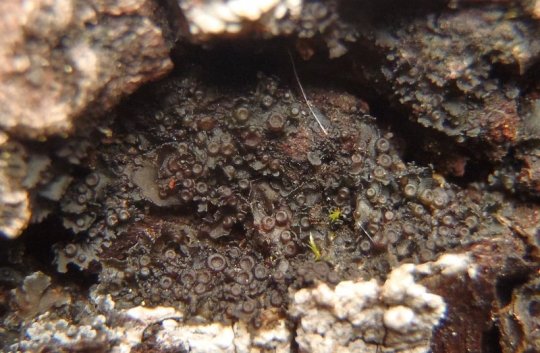
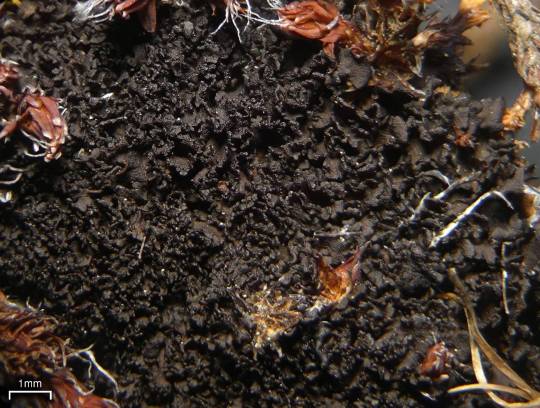






Scytinium intermedium
Intermediate jellyskin lichen, forty-five jellyskin lichen
Nostoc is the most common genus of lichen associate cyanobacteria. Many species of Nostoc produce water-storing polysaccharides which give Nostoc-associated lichens like S. intermedium a jelly-like texture. This cyanolichen has a thallus made up of gelatinous, scale-like lobes that grow in patches up to 3 cm wide. The surface is smooth and dark green-brown when moist, and wrinkled and dark blue-gray when dry. The lobe margins are down-turned and often incised, and the lower surface has scattered, white hapters (hair-like, hyphal attachment structures). S. intermedium produces thick-margined apothecia which have a constricted base and a concave, brown disc. This squishy little dude grows on mossy soil and tree bases in temperate regions of the northern hemisphere. By the way, I can't figure out where the common name "forty-five jellyskin lichen" came from and I really wanna know. I doubt anyone out there has any insight, but I am happy to entertain theories!
images: source | source | source | source
info: source | source | source
#lichen#lichens#lichenology#lichenologist#mycology#ecology#fungi#biology#nature#bryology#symbiosis#symbiotic organisms#cyanobacteria#fungus#nostoc#Scytinium intermedium#Scytinium#jelly lichen#jellyskin lichen#trypo#trypophobia#I'm lichen it#lichen a day#daily lichen post#the natural world#naturalist#beautiful nature#weird nature#natural science#environmental science
29 notes
·
View notes
Text
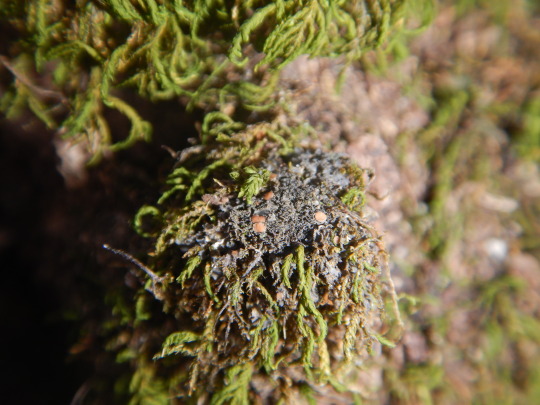
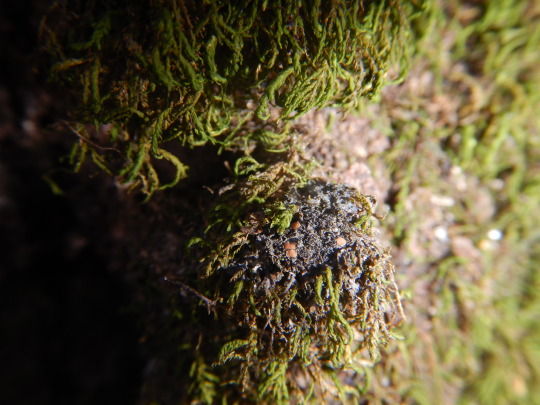
Scytinium juniperum apparently it's g4 rank which is wild and I think it's super under appreciated or at least not noticed enough because it occurs on tree buttresses on hills and also on rocks covered in dry formed Anomadon spp. aka tree skirt mosses and rock poodle mosses.
It's found in dry harsh conditions, which also can be associated to the same niche pelts are often associated with.
Oddly enough that squamulose plating on the thallus isn't the giveaway rather its that orange apothecia that is the indicator for the species of Scytinium. It really is more of a G5 species and could honestly be the easiest first lichen to get to know and a good one to introduce you to the juxtaposed family of collemaceae, or blue jelly skin lichens that all share the same photobiont associations for the most part. The family consists of humidity lovers more often than not and also more of an affiliation rather than the above species which likes more dry air conditions.
Next time your on a dry hill with an Anomadon covered rock look for a weird foliose black/darkblue matt intertwined in it!
10 notes
·
View notes
Text

Scytinium palmatum, growing amongst moss on a rock
4 notes
·
View notes
Text









Scytinium pulvinatum
Looking for a name and logo for your new eco-metal band? Might I suggest my good friend Scytinium pulvinatum? This semi-gelatinous, squamulose-foliose cyanolichen grows in small, compact cushions on mossy trees, rocks, and soil. It has russet brown to dark brown lobes with spiky, frilly margins, and a pale blue-gray lower surface. It has lecanorine apothecia with a concave red-brown disc and thick margin. It has been found in a wide range of habitats throughout Europe and North America from temperate, urban areas to arctic-alpine climbs, which calls into question the accuracy of some of these observations in distinguishing between S. pulvinatum and the morphologically similar S. lichenoides.
images: source | source
info: source
#lichen#lichens#lichenology#lichenologist#lichenized fungus#fungus#fungi#mycology#ecology#biology#symbiosis#symbiotic organisms#cyanobacteria#nostoc#Scytinium pulvinatum#Scytinium#trypo#trypophobia#I'm lichen it#lichen a day#daily lichen post
27 notes
·
View notes
Photo










Scytinium palmatum
Antlered jellyskin lichen, antlered vinyl lichen
I love me some fantasy world-building, so the idea tiny jelly-deer hiding amongst the moist moss in costal forests so that only their antlers are peaking out really got me excited, all thanks to S. palmatum. This foliose cyanolichen has wide, inward-curving lobes that stand erect and tube-like above the soil or mossy rock it typically grows on. It is thin and crispy when dry, and thick and gelatinous when moist, varying in color from dark olive to red-brown to gray to blue-black depending on its level of hydration and habitat. It produces minute apothecia which are concolorous with the thallus and have a recessed disc and thin margin. S. palmatum can be found in mild-temperate humid forests of Europe, eastern Asia, Australasia and the Pacific coast of North America. And his greatest predator is the gummy bear! Not really, but let me dream.
images: source | source | source
info: source | source | source
#lichen#lichens#lichenology#lichenologist#lichenized fungus#fungus#trypo#fungi#mycology#ecology#biology#botany#bryology#systematics#taxonomy#life science#environmental science#natural science#nature#naturalist#beautiful nature#weird nature#the natural world#Scytinium palmatum#trypophobia#Scytinium#jelly lichen#daily lichen post#lichen subscribe#lichen a day
126 notes
·
View notes
Text








Scytinium plicatile
Starfish jellyskin lichen
Jelly lichens are a bit disgusting, but also absolutely delightful! They have a thalli that is thin, wrinkled, and dull when dry, and thick, gelatinous, and shiny when moist. This is due to the polysaccharide matrix of the nostoc cyanobacterial photobiont which absorbs and holds water in its long chains intermixed throughout the thallus! S. plicatile has a subfoliose to squamulose thallus that is reddish brown when dry, and blackish brown when moist. The upper surface is often covered in isidia-like warts (like the skin of a starfish), and the lower surface is pale with pale, tufted cilia. It commonly produces apothecia which have a concave, red-brown disc and a thick margin. S. pilcatile (like other jelly lichens) likes water, and can be found in the seepage cracks of rocks in mild-temperate regions of North America, Europe, and Australasia.
images: source | source | source
info: source | source
#lichen#lichens#lichenology#lichenologist#lichenized fungus#fungus#fungi#symbiosis#cyanobacteria#cyanolichen#mycology#ecology#biology#botany#bryology#life science#environmental science#natural science#nature#naturalist#beautiful nature#weird nature#trypo#trypophobia#cw: warts#cw: trypophobia#Scytinium plicatile#Scytinium#I'm lichen it#lichen a day
32 notes
·
View notes
Text
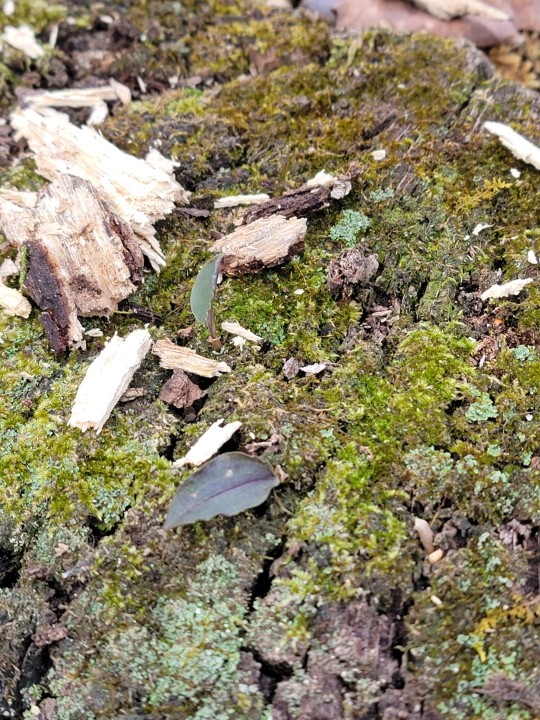
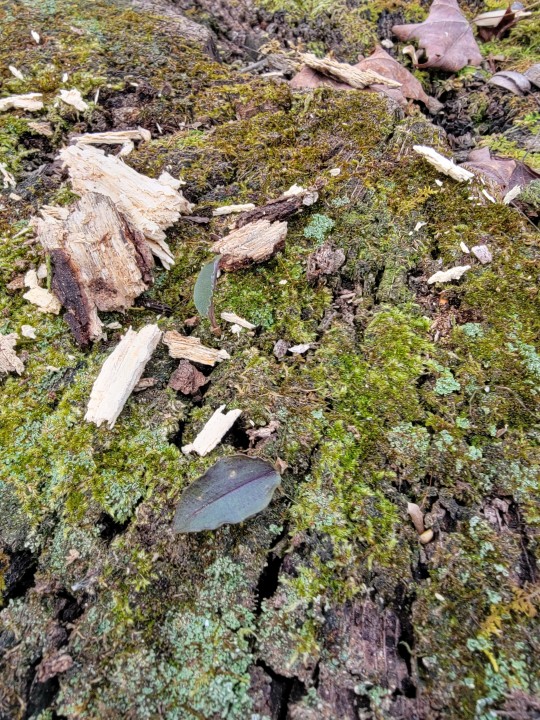

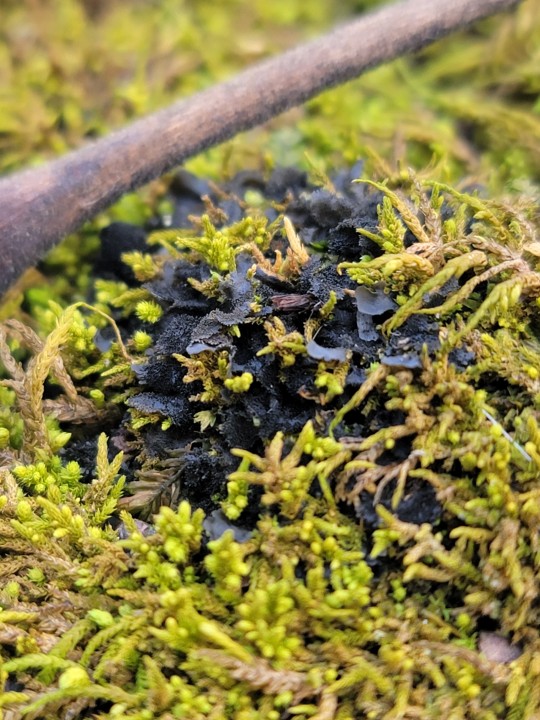

Ok so im gonna bring this up since i thought it was there to add a cool fact and or refresher habitat point. Tipularia discolor is associated with well decayed wood specifically with a late stage white rot inorder for protocorm developememt to start. (Buzzardroost, adams co, edge of ap, tnc, Ohio)
Ok, more jelly lichen! ^
Another species with a look a like or 3. Good thing this family is ok for the vast majority.
Though, some are even different genus. First off I dont think that this looks like a tattered moss eating jelly or leptogium or scytinium but its worth mentioning them since a few sources do. As for Collema, this in theory should be Collema flaccidum, only isidiate with smooth lobed thallus seems right. Ive seen Collema subflaccidum on trees and it is not super common imo in the upper ilp but its the most common Collema in the smokies, known for arboreal habits and is smooth and lacks isidia, often called smooth folded jellyskin lichen.
Below are two ilp examples, one C. subflaccidum from sandstone at rrg from creation falls area, the other is from wilderness trail in adams county.
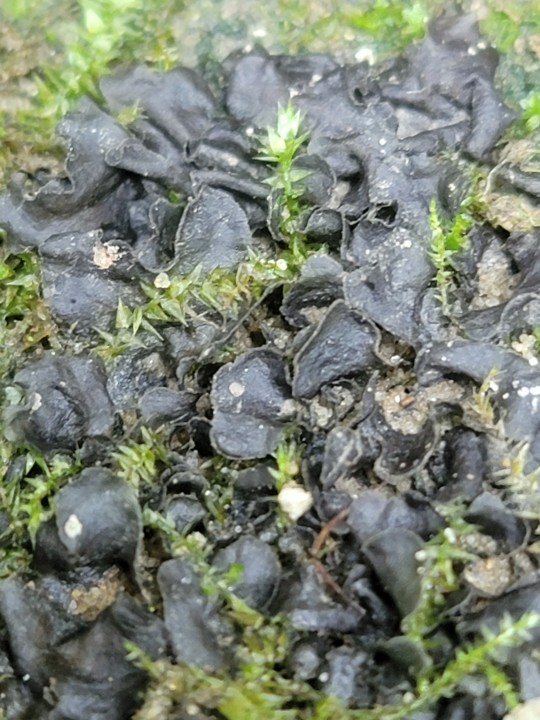


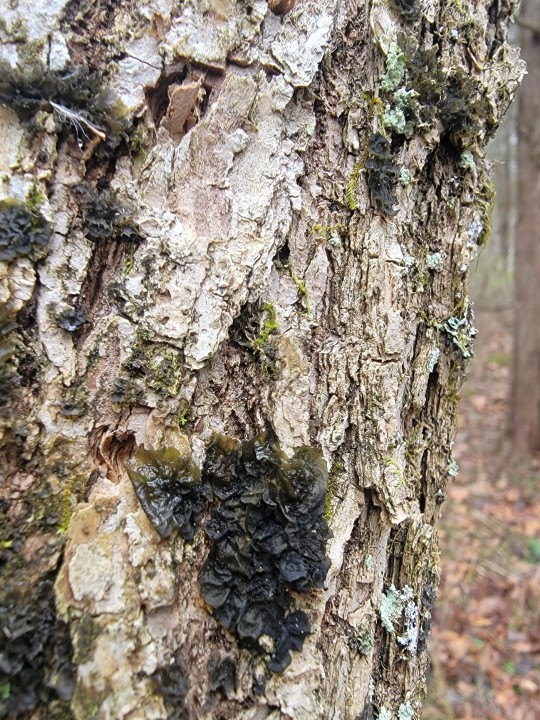

The other lichens look too pelt like and intricate in my opinion but are also mentioned ( Collema pulcellum var. Leucopepum (apothecia be bumpy and pruinose with cool undulate grooves that look like it should be isidiate but isnt and has a large mostly appressed thallus with smooth patches) and C. furfuraceum (literally the same look but has isidiate bumpy ridges and has long conspicuous ridges intead of those dot like bumps.))
Bottom two are isidiate so Collema flaccidum and are saturated so give off more of the textbook look visually.
1 note
·
View note
Photo







Scytinium tenuissimum
Jelly lichen jelly lichen jelly lichen
images: source
#lichen#lichens#lichenology#lichenologist#lichenized fungus#fungus#fungi#mycology#ecology#biology#bryology#botany#biodiversity#systematics#taxonomy#life science#environmental science#nature#natural science#the natural world#naturalist#beautiful nature#weird nature#Scytinium#Scytinium tenuissimum#go outside#take a hike#look for lichens#jelly lichen#i love lichens
39 notes
·
View notes
Photo






Scytinium lichenoides
Tattered jellyskin lichen
One of my greatest sadnesses is that there isn’t a lichen Pokémon yet. So many missed opportunities, so many wonderful species who deserve to be represented. And when I saw the first picture here of these little spongy round friends, I couldn’t help but imagine them popping up out of the rock and rolling around like little Miyazaki soot-sprites! So I would like to put forth S. lichenoides as an ideal candidate for Pokemonization! This foliose lichen forms irregular, wrinkled lobes with ragged margins in round patches or bunches up to 8 cm in diameter. The fringed lobe edges are characteristic for this specific species and help to identify it from similar looking jelly lichens. S. lichenoides of course has a gelatinous texture, and is dark brown to russet in coloration on the upper surface, pale cream and cespitose on the lower surface. Lecanorine apothecia are concolorous with the upper surface. S. lichenoides grows on bark and moss in montane forests In Europe and the Americas. God I love learning about all the good lichens in the world, and I hope the folks at Gamefreak central listen to my pleas and give us a lichen Pokemon soon.
source | source | source | source
#lichen#lichens#lichenology#lichenologist#biology#ecology#mycology#lichenized fungus#lichenized fungi#bryology#botany#not plants#forestry#nature#natural science#naturalist#citizen science#scientist#pokemon#lichenthrope#lichen life#I'm lichen it#nature core#forest core#goblin core#nature asthetic#goblin asthetic
68 notes
·
View notes